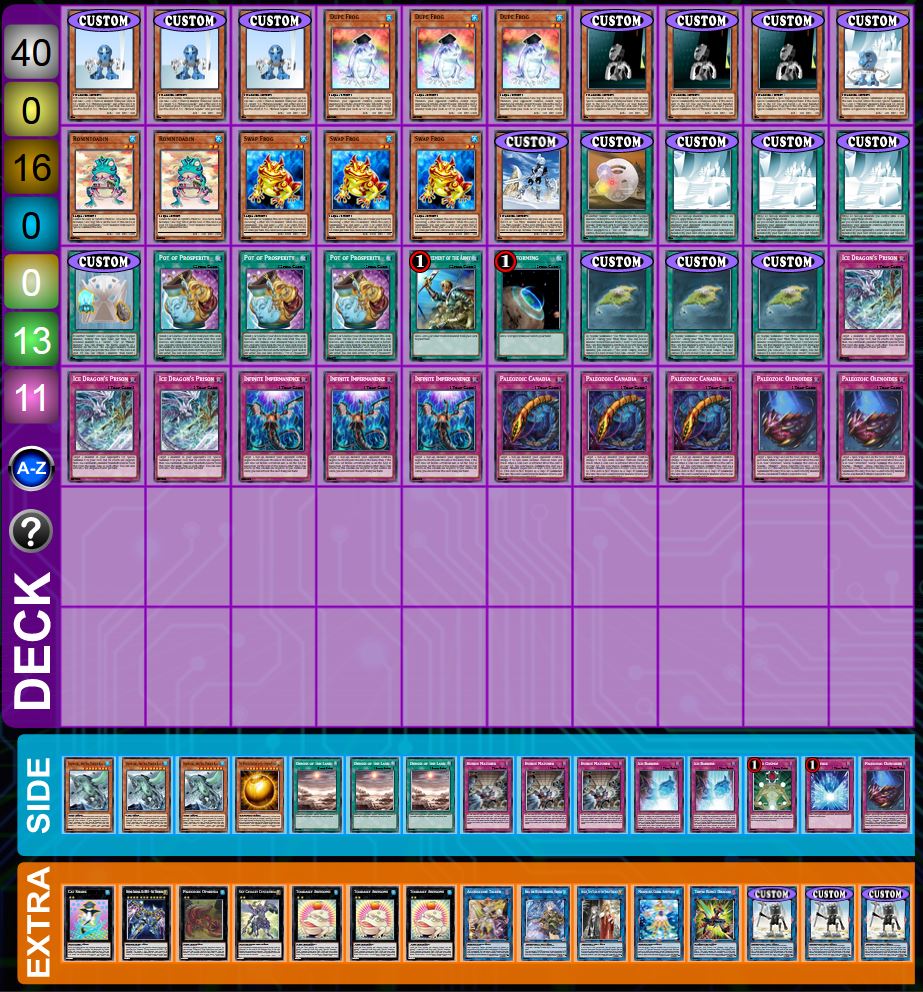When I set out to make Ko-Koro, there were already a few specific goals I was aiming for with the design: It should reflect the principle of Peace that MNOG2 assigned to the village, the playstyle it facilitates should be clearly distinct from the other Koros, and it should especially be incompatible with the Ga-Koro strategy with which it shares the focus on the WATER Attribute. Given these requirements, the following part of the quote at the top of the BS01 “Peace” article stood out to me:
On Mount Ihu, nothing grows and nothing changes. The mountain is perfectly at Peace.
In other words, “Peace” as a concept is (semi-)canonically equated to a lack of change, and in card game terms that comes out to a type of strategy that is as unique as it is controversial – stall. By preventing your opponent from making progress towards victory, you buy yourself the time to achieve some win condition that would normally be too slow to work. And this inherent slowness gives us a nice big point of distinction from Ga-Koro, which is all about quick effects and playing on both your and your opponent’s turn.
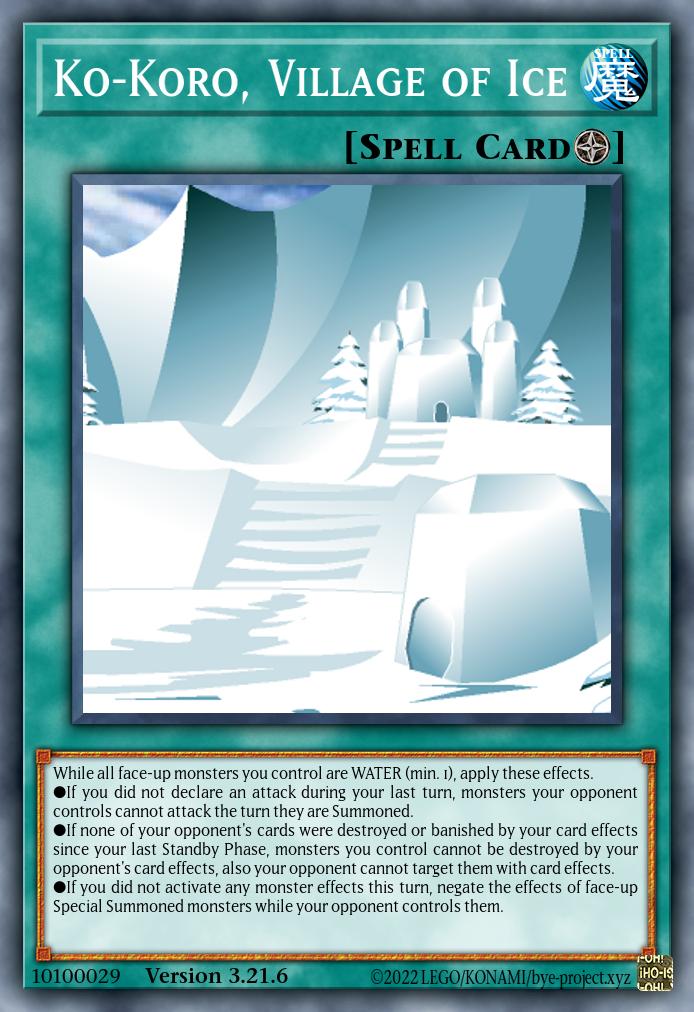
Ko-Koro, Village of Ice
Field SpellWhile all face-up monsters you control are WATER (min. 1), apply these effects.
●If you did not declare an attack during your last turn, monsters your opponent controls cannot attack the turn they are Summoned.
●If none of your opponent’s cards were destroyed or banished by your card effects since your last Standby Phase, monsters you control cannot be destroyed by your opponent’s card effects, also your opponent cannot target them with card effects.
●If you did not activate any monster effects this turn, negate the effects of face-up Special Summoned monsters while your opponent controls them.
With that settled as the direction I wanted to go in, I sketched up the Ko-Koro field spell with three effects that limit your opponent on the condition that you also limit yourself in a similar way (much like a peace treaty), all under the shared condition that your monsters are all WATER to establish that Attribute focus. While the basic outline of this idea survived testing pretty much unchanged, the details of the effects underwent a lot of changes, so let’s just look at them point by point:
- If you did not attack during your last turn, your opponent’s monsters cannot attack on the turn they are Summoned. This effect started life as a total attack lock with the same condition and I honestly think that might have been fine in a realistic environment, but apparently the EDOPro AI is completely unable to deal with this type of restriction and it leads to the overly long stall games everybody hates, so I had to tone it down a bit. If the strategy works as intended, this honestly barely makes a difference, for reasons I’ll get into in a bit.
- If you did not banish/destroy any of your opponent’s cards since your last Standby Phase, your monsters get targeting and destruction protection. This one is super significant since the blanket protection makes it very hard for your opponent to break through even otherwise unimpressive opening boards, enabling you to build on them in consecutive turns until you reach something actually game-winning. On the other hand, the condition attached to it requires you to opt out of the vast majority of removal, massively influencing deckbuilding and the design of other cards related to Ko-Koro. Initially, the restrictions were even harsher as you were not allowed to make your opponent’s cards leave the field with your effects in any way whatsoever, but after one particularly atrocious test duel I realized this just forces you into situations where you cannot possibly clear the way to deal damage and are stuck passing back and forth for like 40 turns. Speaking of damage, I briefly had an extra stipulation that did not allow you to deal effect damage if you wanted this protection (because burn of all things as a win condition for an ice deck is kinda stupid), but then I remembered Wave-Motion Cannon exists and enables burn wins without ever needing to deal damage while you are stalling. So I gave up on that restriction – I will be judging you if you play Ko-Koro Burn, but you are free to do so.
- During turns in which you did not activate any monster effects, your opponent is pretty much under
Lose 1 Turn (sans position changing)Skill Drain (for Special Summoned monsters). The main purpose of this one is to prevent most decks from comboing into big bosses that just win them the game even under Ko-Koro’s restrictions, while also ruining any possible Ga-Koro synergy with its condition. It actually didn’t change much from its very first draft to its initial release, unlike the other two. I honestly think “no monster effects for you” is generally a cool drawback on a big floodgate, as it pretty much prevents it from being used in tandem with an oppressive board of negating and disrupting Extra Deck monsters. One thing that did get dropped on a later revision was the limitation that effects only stay negated during the turn the monster is summoned, because it just made you way too vulnerable to something as simple as Special Summoning a monster during your End Phase.
Overall, the payoffs for these effects make it so that your opponent has a very hard time doing anything to your monsters unless they get an extra turn of setup so they can attack, while the restrictions greatly limit your ways to counteract that setup. The game you play under Ko-Koro essentially consists of using your limited options to keep your opponent off anything that could break them out of this stall situation, while gradually building momentum turn by turn until you reach a point where you are ahead far enough to safely break the peace and go on the offensive.
But if we want to avoid destruction, banishment, and battle, how are we actually supposed to get the opponent’s monsters off the field before they stop being affected by Ko-Koro? Some generic real cards can do that of course, but the answer that exists natively within this village’s support is Turaga Nuju.

Turaga Nuju
Link Effect MonsterLink-2 [◀ ▶] | WATER Spellcaster | ATK 11002 monsters, including a WATER Warrior monster
If this card is Special Summoned: You can target 1 face-up Spell/Trap you control; until the end of the next turn, while you control a WATER monster, that target cannot be destroyed by card effects (even if this card leaves the field). Once per turn: You can target any number of cards your opponent controls; change face-up monsters you control to face-down Defense Position, equal to the number of targeted cards, and if you do, return those targeted cards to the hand.

Noble Kanohi Matatu
Equip SpellIf another “Kanohi” card becomes equipped to the equipped monster, destroy this card. Once per turn, while this card is equipped to a “Turaga”, “Toa”, or “Makuta” monster: You can change the battle position of 1 monster on the field. The equipped monster cannot attack the turn you activate this effect. If this card is in your GY: You can Tribute 1 monster, then target 1 “Turaga Nuju” in your GY; Special Summon it and equip it with this card. You can only use this effect of “Noble Kanohi Matatu” once per turn.
Being concerned with the future as he is, the first thing Nuju will do upon entering the field is protect a face-up Spell/Trap from destruction for a short while, and he himself doesn’t need to stay around for this – you just need any WATER monster. Now, the idea here is obviously to target Ko-Koro, hopefully leading to a situation where your opponent cannot get rid of your monsters because of the Field Spell, but also cannot get rid of the Field Spell before dealing with your monsters. Other applications are quite limited, and while this one important use case is kinda enough, I am strongly considering also allowing face-down targets for just a bit of extra utility.
But the main point of the card lies in the second effect, representing the most notable trait of the Turaga of Ko-Koro: He communicates almost exclusively in bird language. And thus, he has a removal effect that is tailored for the strategy and designed in the “language” of birds, specifically those of the frosty variety, by which I mean exactly Penguins. By flipping one or more of your monsters face-down, he returns the same number of cards your opponent controls to the hand, resetting any progress made towards escaping the Ko-Koro lock. Get it, because there are Penguins in the game that bounce stuff when they flip, haha
Meanwhile, the Kanohi Matatu is a non-targeting “telekinetic” battle position changer, and one neat way to use it is to flip the monster you used for Nuju’s effect back up and trigger some effect that way. Yes, the mental focus required for that on the noble version means you don’t get to attack with the equipped monster the same turn, but being able to reuse a Penguin Soldier seems well worth that.
Or, if bouncy birds are not your speed, maybe I can interest you in some villagers who also have beneficial interactions with the strategy.

C.C. Matoran Kopeke
Effect MonsterLevel 2 | WATER Warrior | ATK 300 / DEF 600If this card is Normal Summoned or flipped face-up: You can add 1 Level 2 Warrior monster from your Deck or GY to your hand, except “C.C. Matoran Kopeke”, then, if you added a non-WATER monster by this effect, place 1 card from your hand on top of the Deck. You can only use this effect of “C.C. Matoran Kopeke” once per turn. If another “C.C. Matoran” monster(s) you control would be destroyed, you can change this card to face-down Defense Position instead.
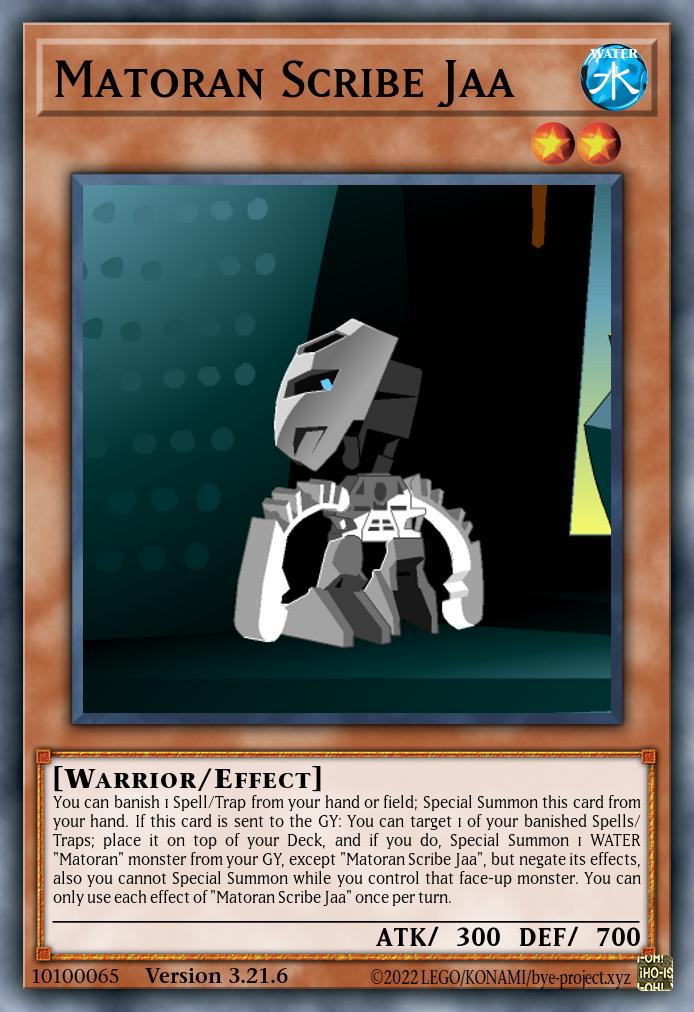
Matoran Scribe Jaa
Effect MonsterLevel 2 | WATER Warrior | ATK 300 / DEF 700You can banish 1 Spell/Trap from your hand or field; Special Summon this card from your hand. If this card is sent to the GY: You can target 1 of your banished Spells/Traps; place it on top of your Deck, and if you do, Special Summon 1 WATER “Matoran” monster from your GY, except “Matoran Scribe Jaa”, but negate its effects, also you cannot Special Summon while you control that face-up monster. You can only use each effect of “Matoran Scribe Jaa” once per turn.
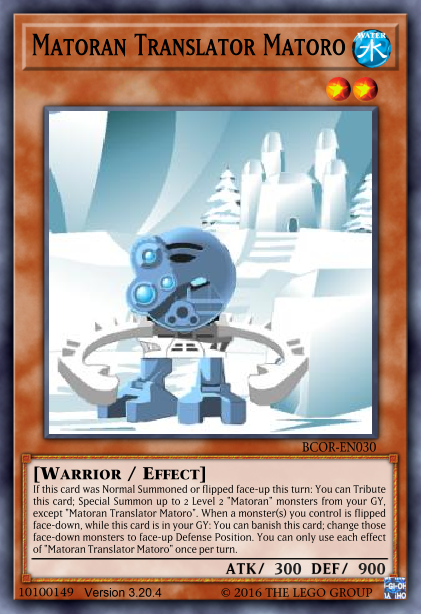
Matoran Translator Matoro
Effect MonsterLevel 2 | WATER Warrior | ATK 300 / DEF 900If this card was Normal Summoned or flipped face-up this turn: You can Tribute this card; Special Summon up to 2 Level 2 “Matoran” monsters from your GY, except “Matoran Translator Matoro”. When a monster(s) you control is flipped face-down, while this card is in your GY: You can banish this card; change those face-down monsters to face-up Defense Position. You can only use each effect of “Matoran Translator Matoro” once per turn.
Kopeke, the resident Chronicler’s Company member, is a classic searcher on Normal Summon who also works when flipped face-up. This means that in a stall situation where your opponent can’t remove your monsters and you keep flipping and bouncing with Nuju, you get a search every turn. You get to pick from a fairly wide (but not particularly powerful) pool of all Level 2 Warriors, but for best advantage you want to pick the WATER ones, meaning Ga- and most importantly Ko-Matoran.
For example, getting Jaa is an easy way to set up Nuju. This scribe who writes down translations from the Wall of Prophecy has a pair of effects that, if used with Kopeke already on the field, really just amount to a Nuju ready to bounce at least one card and a Spell/Trap stacked on top of the Deck (this one’s the prophecy part). Ko-Koro decks generally being heavy on Spells and especially Traps (because they cannot disrupt with monster effects) means you should usually have the necessary fodder, and the nasty Special Summon restriction on the monster you bring back from the GY is conveniently turned off the moment Nuju flips it face-down.
Going even further beyond, Matoro is a Normal Summon for later in the game and trades himself off for up to 2 Level 2 Matoran in your GY. In his function as Nuju’s translator, he is also able to dispel the confusion caused by the Turaga’s use of bird language on your side of the field, immediately unflipping your newly face-down monsters. This basically speeds you up by a turn, lets you immediately trigger (pseudo-)flip effects, and gives you material for maybe ending the game with a big boss monster while your opponent’s field is clear.
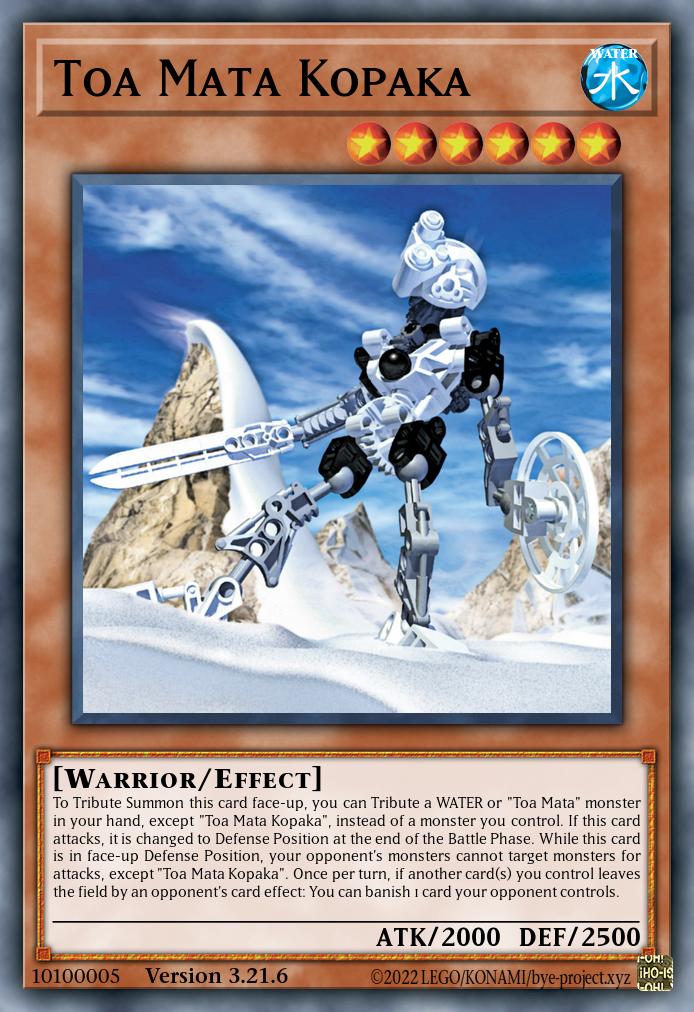
Toa Mata Kopaka
Effect MonsterLevel 6 | WATER Warrior | ATK 2000 / DEF 2500To Tribute Summon this card face-up, you can Tribute a WATER or “Toa Mata” monster in your hand, except “Toa Mata Kopaka”, instead of a monster you control. If this card attacks, it is changed to Defense Position at the end of the Battle Phase. While this card is in face-up Defense Position, your opponent’s monsters cannot target monsters for attacks, except “Toa Mata Kopaka”. Once per turn, if another card(s) you control leaves the field by an opponent’s card effect: You can banish 1 card your opponent controls.
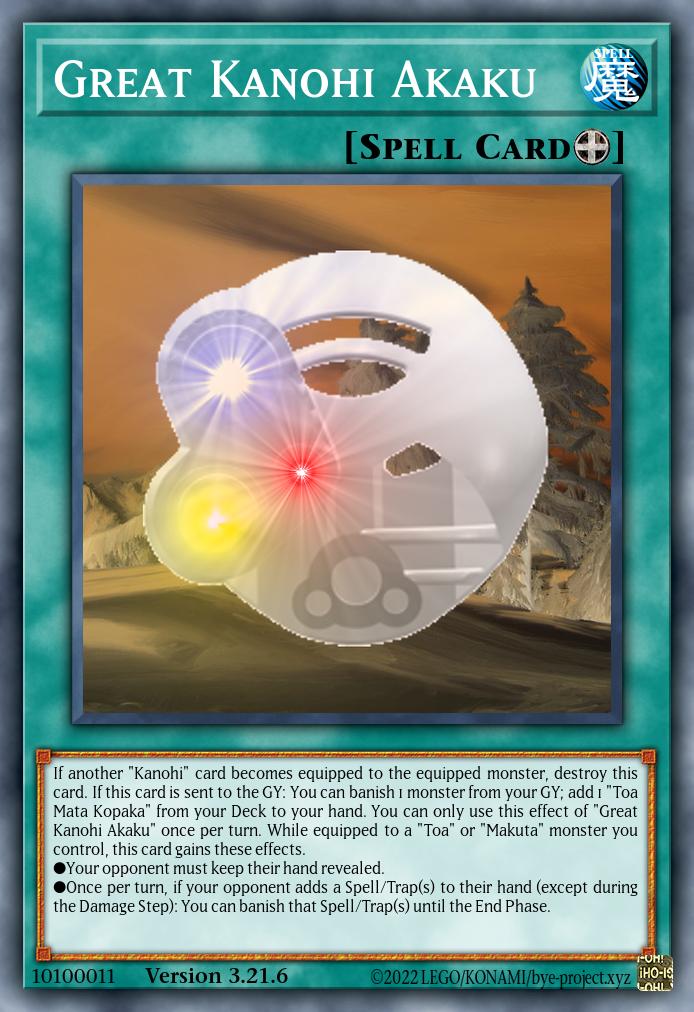
Great Kanohi Akaku
Equip SpellIf another “Kanohi” card becomes equipped to the equipped monster, destroy this card. If this card is sent to the GY: You can banish 1 monster from your GY; add 1 “Toa Mata Kopaka” from your Deck to your hand. You can only use this effect of “Great Kanohi Akaku” once per turn. While equipped to a “Toa” or “Makuta” monster you control, this card gains these effects.
●Your opponent must keep their hand revealed.
●Once per turn, if your opponent adds a Spell/Trap(s) to their hand (except during the Damage Step): You can banish that Spell/Trap(s) until the End Phase.
Finally, Kopaka is one of the major ways you can actively put pressure on your opponent amidst this stall-focused playstyle, and that is despite him technically being a mostly defensive card. The key point is that he can, to a degree, let you ignore Ko-Koro’s restriction on attacking, as he will change himself to defense at the end of the Battle Phase and proceed to redirect any attacks from your opponent’s side into his hefty 2500 DEF butt (incidentally, this marks the first actual stat change I’ve made in the BCOT overhaul – 2000/2150 was just a bit underwhelming). He also kind of indirectly protects your other cards (such as Ko-Koro itself) from removal effects by punishing any harm to those on his side with a non-targeting banish – this would turn off Ko-Koro’s protection and negation effects, but in the case where that’s the card that got removed, it doesn’t matter, right?
Protecting Ko-Koro is also the intent of the Kanohi Akaku, which uses its power of X-Ray vision to see through the opponent’s hand and can temporarily snipe out a freshly added Spell or Trap with expert precision. Since Spells in particular represent the most common form of generic S/T removal next to Extra Deck monsters that are neutered by Ko-Koro itself, this potentially takes those threats to your attempted lockdown out of the equation until you’ve had time to prepare for them.
Sample Deck
Ko-Koro forces you to forgo monster-based disruption if you want to use it as a proper floodgate, so in order to not get completely wrecked every time an opponent does manage to play through the village’s passive restrictions (or we just don’t draw it), the logical move seemed to be using lots of Traps to fill this hole. And when WATER and Traps are in the requirements, the answer probably lies in Paleozoics with a decent helping of Frogs.
Starting from the boring parts, we have the classic Frog engine of Dupe Frog, Ronintoadin, and Swap Frog plus Paleozoics Canadia and Olenoides to get lots of Aqua Level 2s. Why only two Olenoides in the Main Deck and no Dinomischus? Because we don’t want to destroy or banish anything if we can help it, but also can’t justify skipping out on Spell/Trap removal entirely.
To make Nuju, we need WATER Warriors, and so we have the Ko-Matoran lineup of triple Kopeke, triple Jaa, and a single Matoro. Normal Summoning Kopeke and searching Jaa gives you Nuju with fodder to bounce at least one card, assuming we have access to even a single one of the Spells and Traps that make up more than half of the Deck (an especially good play is using Mata Nui to search Ko-Koro and then using the island still on the field to fuel Jaa’s effect). Matoro is a secondary search target to speed things up a bit once the engine is running, playing more than one would probably be justifiable as well. Our final WATER Warrior is Kopaka, but he’s more for edge cases and lethal pushes than for Nuju material.
The Spells are merely Ko-Koro itself plus its searcher Mata Nui, the Kanohi, and basic consistency stuff, so not much to say there. For non-Paleo Traps, I included Ice Dragon’s Prison as nontargeting removal (clashes with Ko-Koro, but sometimes you can’t avoid that – at least it’s an ice card) and Infinite Impermanence as just about the only major handtrap we can use without disabling the floodgate.
The Extra Deck is a mix of Links and Rank 2 Xyzs, most importantly Nuju and Toadally Awesome. Another inclusion to deal with untargetable stuff is Sky Cavalry Centaurea, and amusingly enough, using that sets you up perfectly for Zeus. Of course, neither of those are WATER, so once you do that you’re at least temporarily abandoning the usual Ko-Koro strategy. But hey, gotta have a Plan Z.
Funny things in the side deck include Gameciel and Sphere Mode Ra for going second, Demise of the Land and Metaverse to hit your opponent with the Ko-Koro floodgate as a surprise, Evenly Matched and Macro Cosmos because even though their effects make cards get banished it doesn’t count as cards being banished by your effects (’tis a very silly game), and Ice Barrier as another nontargeting removal option (also an ice card!).
Best of Test
This deck performed quite interestingly in testing. Not only did it have the highest winrate out of everything I’ve put through the structured test circuit so far (mostly because the AI is unable to play under Ko-Koro), its good and bad matchups were also quite different from usual. In particular, this was the only deck so far that won its match against the Dragoon AI (by simply never letting the boy come out), and also the only deck that lost the match against the Chain Burn AI (turns out going slow and protecting your field is a bad strategy against heaps of effect damage, and Ojama Tokens screw me over to a hilarious degree).
Conclusion
The central strategy of Ko-Koro is restricting yourself in order to slow down your opponent as well, and then using the fact that you’re better adapted to playing under these limitations to gradully approach a game-winning position. This is a very unusual playstyle with a lot of weaknesses, such as Ko-Koro doing almost nothing against already established boards (though this point was somewhat helped by unlimiting the effect negation), but between the additional support offered by powerful Traps and the AI’s sheer inability to counteract what you’re doing, it worked so well in testing that I kind of had a hard time justifying any buffs. As a result, the cards this time may be a bit undertuned if you wanted to use them against a human opponent with brain cells and all that, but that may not matter much when the main use case for EDOPro custom cards is just the AI.
As a final note, despite my doubts about the powerlevel, I must say I’m very happy with some other aspects of the design, in particular how “icy” it ended up being:
- It accomodates some ice-related cards like the Penguins, Ice Dragon’s Prison, and Ice Barrier really well.
- The strategy of going first and preventing battle stands in perfect contrast to Ta-Koro, were you want to go second and battle as much as possible.
- The crucial need to accurately judge when you can start pushing for victory and turn off Ko-Koro without screwing yourself mirrors the Ko-Matoran’s focus on knowledge and foresight.
- The deck melts against burn like an ice cube in the sun.

